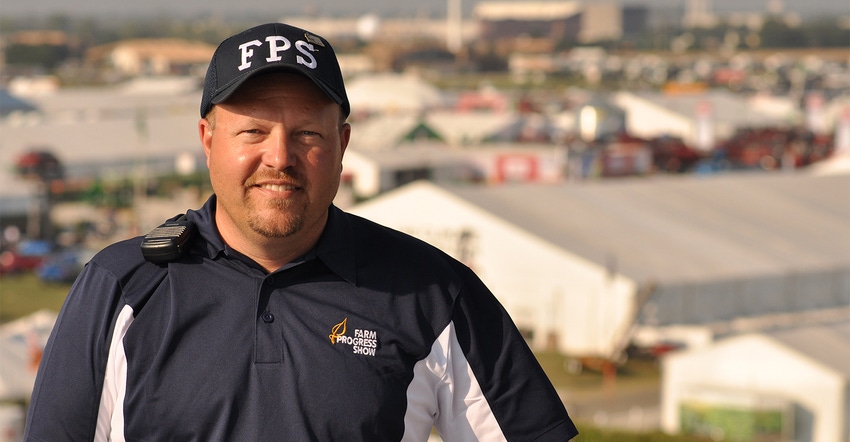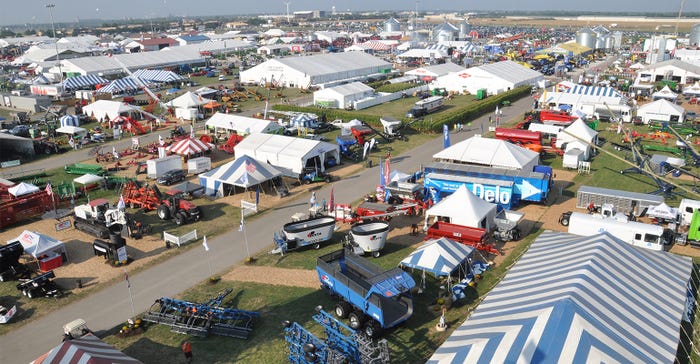
In 2017, the Farm Progress Show comes back to Decatur Aug. 29-31. And like every year, the show staff is already busy tweaking, improving and expanding to make the show experience even better for the farmers who attend. Prairie Farmer recently sat down with colleague Matt Jungmann for a look at what he and his staff are up to these days. Jungmann is national events director for Penton Ag, the parent company of Prairie Farmer and the Farm Progress Show.
PF: We’re more than six months out from the 2017 Farm Progress Show. What are you up to these days?
Jungmann: This is the time of year when I’m visiting other farm shows and having conversations with exhibitors about how the exhibit field will look. Agriculture changes fast, especially with mergers and acquisitions. You don’t realize how much change there is until you leave that site for a year or two. We’re looking at big cornerstone exhibits that will change. There’s a lot of change in ag, and the exhibit field will reflect that.
PF: How does the Decatur site look?
Jungmann: The site is in great shape, and we’re looking at basic maintenance. We’ve been there since 2005, so more than a decade of Farm Progress Shows means paving needs repaired. What was brand-new and shiny now needs to get fixed up after six shows. This will be the seventh show in Decatur.
PF: What’s happened in our absence on the Decatur site?
Jungmann: The biggest change is a big new Case IH building. They’re putting up a beautiful building, and it’s just about completed. They’ll have dedicated meeting space, where in the past that’s been done in a mobile office-type trailer. It will give visitors a nice firm footing with a concrete floor. The things they used to do in a tent they can do better in a building.
PF: What’s the exhibit mapping process like?
Jungmann: It’s an ongoing process that starts at noon on Wednesday the year before. In effect, at that point, the show’s over and everybody’s looking forward. So a lot of the 2017 show conversations started in August 2015.
PF: How do you figure out which companies go where?
Jungmann: We’re at the point now where the talking is over and you have to make it on a map. We’re asking, "How many lots do you want? Who do you want next to you?" It’s an enormous 600-piece jigsaw puzzle where many have a special need or wish or dream. All 600 want to be next to the Main Gate, next to a food court, next to the field demos. And we have to say, "That’s not possible, so what do you really want?" We’re having those conversations and getting priorities in order.
PF: Do you get involved with special requirements?
Jungmann: A little bit, especially with infrastructure. Do they have a water line near them? Do they have the power they need? Do they need generators to run all the air conditioners? We’re facilitating conversations: "If you’re going to do this super-fantastic idea with laser light shows, keep in mind you need to talk to Mark [electrician] for power, and you’ll have to remove the condensation that air conditioning creates, and you’ll need to bring in fuel overnight." We’re looking to head off problems before they become a problem on-site.
PF: How big of a deal is the Farm Progress Show for companies?
Jungmann: This is the big one, especially for corn and soybeans. Most big exhibitors do six or seven shows corporately. If they’re in Midwest ag, there are a few shows that bubble to the top — FPS, Husker Harvest Days, National Farm Machinery Show. FPS is certainly the big one. It’s also the first one on the calendar. Everything is fresh and new before it hits the fall show cycle.
Plus, this is where they’re putting their company on display. Their exhibit is for their own staff and bosses and stockholders — Wall Street — in addition to the primary function, which is to have conversations with growers.

PUZZLE: Drawing up the exhibit field map isn’t exactly easy, says Matt Jungmann, national events director for Penton Ag. “It’s an enormous 600-piece jigsaw puzzle where many have a special need or wish or dream. We’re having those conversations and getting priorities in order,” he adds.
AERIAL: The Farm Progress Show exhibit field is laid out in a grid with 40-by-70-foot lots, Matt Jungmann says. A typical endcap position on Central Avenue is eight lots, or 160 feet by 140 feet. The major companies typically take 20 lots. Jungmann says there are also a lot of single-lot exhibitors, and everything in between.

PUZZLE: Drawing up the exhibit field map isn’t exactly easy, says Matt Jungmann, national events director for Penton Ag. “It’s an enormous 600-piece jigsaw puzzle where many have a special need or wish or dream. We’re having those conversations and getting priorities in order,” he adds.
About the Author(s)
You May Also Like






